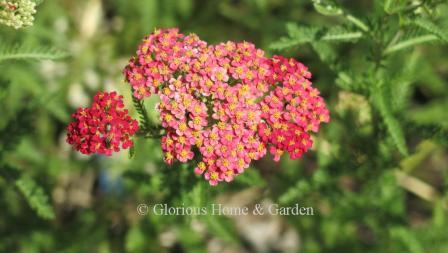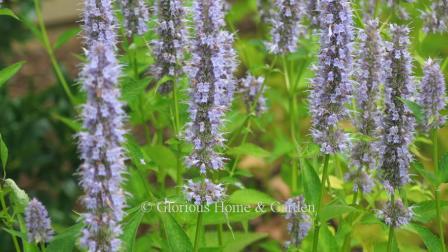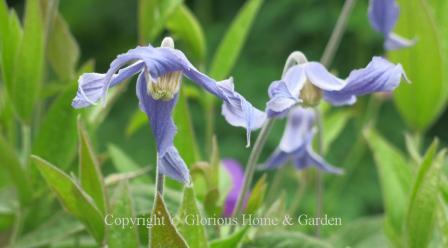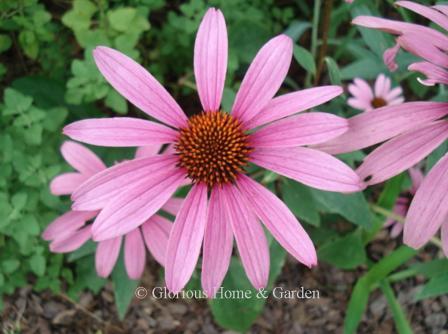- Home
- The Summer Garden
- Summer Perennials A-E
Summer Perennials are the Stars of the Summer Garden
Finally, summer is here! Time for barbeques, trips to the beach--and summer perennials. Every year, I wish spring would never end. I love all the flowers of spring: the daffodils, tulips, azaleas, dogwoods, redbuds and more, but after they have faded, there is a host more to come bringing color, scent, and excitement to the garden. This is the time for many herbaceous perennials such as coneflowers, daylilies, hostas, phloxes, salvias, yarrows and many more to take center stage.
Summer perennials can be used in so many ways. They are stalwarts of the border, of course, but they can also be used en masse as ground covers, as specimens, as collections of a particular species, or even in containers singly or combined with annuals. Since I’m the type of gardener who has to have some of everything, I try to locate my perennials in the border for season-long bloom with thought to height, foliage texture, and color combinations.
One can have such fun
with color combinations using perennials in the garden. How about a garden or border of all warm
colors like yellow, orange and red interspersed with white to set them
off? Or bring down the temperature with
cooler colors like blues, lavenders, purples again with lots of white. Or, one could go monochromatic with shades of
a single color. Since my sunny perennial
area is not that big, I like to have a variety, so I tend to use cooler colors
in the late spring and early summer with things like foxgloves, delphiniums,
geraniums, and salvias, transition to daylilies, yarrows, coreopsis, and phloxes
for mid-summer and close out the season with sedums, rudbeckias, asters, and
salvias like the red of pineapple sage and deep blue of ‘Indigo Spires.’
Most of these summer perennials appreciate at least 6 hours of full sun a day, though some, like astilbes and hostas are shade lovers.
"The love of gardening is a
seed once sown that never dies."
- Gertrude Jekyll
Acanthus—Bear’s Breeches
Acanthus mollis, bear's breeches, Zones 7-10. The handsome, lobed leaves of acanthus were the inspiration for the leaf design of the Corinthian capital of ancient Greek architecture. As a garden plant, acanthus sends up tall spikes of white and lavender blooms in late spring to early summer, and the leaves add a bold architectural texture to the border.
 Acanthus mollis
Acanthus mollisAcanthus spinosus, spiny bear’s breeches, Zones 6-10. Spiny bear’s breeches have more deeply cut foliage compared to the softer, rounded lobes of A. mollis.
 Acanthus spinosus
Acanthus spinosusAchillea - Yarrow
Achillea filipendulina, fern-leaved yarrow, Zones 3-8. This species of yarrow has green deeply dissected, aromatic soft ferny foliage on taller plants (3-4’) than the hybrids below—great for the back of the border. Yellow flowers appear on large, flat dense plates. As with all yarrows, full sun and good drainage are essential. The best-known cultivars are ‘Cloth of Gold,’ and ‘Gold Plate.’
Achillea hybrids, yarrow, Zones 3-7. Large clumps of yarrow topped with flat rounded plates of pale yellow to deep gold are some of the best and most distinctive of the summer perennials. Grow in full sun in good, well-drained garden soil, as they prefer hot, dry, sunny conditions. They tend to be longer-lived in areas with low summer humidity and less rainfall.
Some of the best-known yarrows are hybrid crosses between species or inter-hybrid crosses. These have A. filipendulina in their DNA which provides the ferny foliage.
‘Anthea,’ soft yellow with gray-green foliage, about 12-18” high.
'Coronation Gold,' deeper yellow with silvery-green foliage, 30-36” high.
 Achillea 'Coronation Gold'
Achillea 'Coronation Gold'‘Little Moonshine,’ lemon-yellow. A shorter version of ‘Moonshine’ to about 12-14.”
‘Moonshine,’ lemon yellow with ferny gray-green foliage. Grows about 18-24.”
 Achillea 'Moonshine'
Achillea 'Moonshine'Achillea millefolium, common yarrow, Zones 3-9. Soft, ferny foliage and an abundance of blooms characterize this yarrow. The mass of ferny foliage spreads to form a soft, low-growing mat from which arise 1-to-2’ flower stalks. The individual flowers are tiny, but there are many of them. A wide range of colors are available from white to cream, yellow, orange, pink and red. Colors do not reliably come true from seed, so it is best to purchase plants of the desired color. Cultivars of A. millefolium include ‘Appleblossom,’ light pink; ‘New Vintage White,’ white; ‘Oertel’s Rose, shades of pink; ‘Paprika,’ red and yellow; ‘Red Velvet,’ red; and ‘Terracotta,’ orange-red. Creative breeders have also been crossing A. millefolium with A filipendulina hybrids and have given us some very exciting new garden varieties including ‘Apricot Delight,’ apricot; ‘Pink Grapefruit,’ pink; ‘Pomegranate,’ red; and ‘Saucy Seduction,’ dark pink.
 Achillea millefolium 'Oertel's Rose'
Achillea millefolium 'Oertel's Rose' Achillea millefolium 'Paprika'
Achillea millefolium 'Paprika'Agastache, anise hyssop, hummingbird mint, Zones 5-8. Anise hyssop is an aromatic plant in the mint family that has escaped the herb garden and found its way into the summer perennial border, especially with some of the new cultivars. Agastache foeniculum is native to the plains of the American Mid-West and Canada, grows 2-4’ tall with purple flowers and prefers full sun and good drainage. The leaves have a licorice scent when crushed. Anise hyssop is beloved by hummingbirds, bees and butterflies. Cultivars have been developed by crossing several species to select for size, color and cold tolerance. Colors range from yellow to peach, orange, pink, red, purple and blue. ‘Blue Fortune’ has blue flowers and grows about 3’ tall; ‘Desert Sunrise’ has reddish-pink flowers and grows 3-6’ tall; ‘Firebird’ has orange blooms and reaches 2-3’; ‘Peachie Keen’ boasts peachy-pink flowers on a 2’ plant; and ‘Tutti-Frutti’ has pink flowers on a 3 to 6’ plant.
 Agastasche 'Blue Fortune'
Agastasche 'Blue Fortune' Agastache x 'Morello'
Agastache x 'Morello'Alstroemeria, Peruvian lily, Zones 6-9. We are so used to seeing alstroemerias in cut flower bouquets and for sale in bunches at the supermarket that we don’t consider them for growing in our own gardens. And that is a pity, because alstroemerias are some of the most rewarding perennials one can grow. New hybrids have been bred for increased cold hardiness. Alstroemerias originated in South America, they grow from tubers, and their requirements include full sun and organically rich, well-drained soil. The color range is extensive and includes white, cream, yellow, orange, pink, rose, red, and purple. and the flowers are often multi-colored and include spots or stripes of contrasting colors. There are varieties with variegated foliage, too.
 Alstroemeria 'Casablanca'
Alstroemeria 'Casablanca' Alstroemeria 'Freedom'
Alstroemeria 'Freedom' Alstroemeria 'Sweet Laura'
Alstroemeria 'Sweet Laura'Armeria maritima, sea thrift, Zones 4-8. The tolerance to salt air earns this summer perennial its common name. From a grassy tuft of leaves arise globular flower heads in colors of pink, mauve or white flowers. Cultivars include: ‘Alba,’ white; ‘Dusseldorf Pride,’ with deep pink flowers; ‘Nifty Thrifty,’ variegated foliage with pink flowers; ‘Varretu,’ light pink.
Armeria pseudarmeria, false sea thrift, Zones 4-9. Similar to A. maritima in colors of white, pink, red or purple. A low-growing plant that needs full sun, it is suitable for rock gardens and borders. The Ballerina Series comes in several colors.
 Armeria pseudarmeria 'Ballerina Lilac'
Armeria pseudarmeria 'Ballerina Lilac'Artemisia absinthium, wormwood or absinthe, Zones 3-9. Grown for their soft, silvery-gray foliage, artemisias are wonderful to combine with other perennials in the border. They demand full sun and excellent drainage.
 Artemisia 'Powis Castle'
Artemisia 'Powis Castle'Asclepias tuberosa, butterfly weed, Zones 4-9. You see butterfly weed growing along the roadsides in late spring and summer, but it makes a fine garden plant too, attracting hummingbirds, bees and butterflies to the garden. They bloom at the same time as Hemerocallis fulva, the common daylily, making me think of it as the "orange time of year." Not fussy as to soil, Butterfly weed grows to about 2-3', and does best in full sun. It has a long taproot, so it is best left undisturbed once established. As a member of the milkweed family, its seed can be widely disbursed by wind, so best to pick off the seedpods of this summer perennial before they open. 2017 Perennial Plant of the Year.
 Asclepias tuberosa
Asclepias tuberosaAstilbe x, meadowsweet or false spirea, Zones 4-8. Here is a great summer perennial to add color to a wooded area. Astilbes loves partial shade, rich, humus-y soil and consistent moisture-- not a good choice for dry conditions. The ferny foliage and feathery plumes of the flowers combine well with ferns, foamflowers, heuchera, bleeding hearts, hellebores, hostas, and more. They come in a wide variety of colors including white, pink, peach, coral, red, and lavender. Some varieties to try include ‘Amethyst,’ lavender; ‘Bridal Veil,’ white; ‘Elizabeth Bloom,’ pink; ‘Fanal,’ red; ‘Peach Blossom,’ peach.
 Astilbe x arendsii 'Amethyst'
Astilbe x arendsii 'Amethyst'Astrantia major, great masterwort, Zones 5-7 I saw a lot of astrantia used in gardens on a recent trip to England. I have not seen it in Georgia gardens or nurseries, probably because it would not do well in our heat and humidity. but it should do better in the Northeast and Northwest where nighttime temperatures are cooler. Provide full sun to partial shade, ample moisture and well-drained humus-rich soil. Available in whites, pinks and reds, astrantia begins blooming in late spring and continues throughout the summer. Cutting back in late summer is said to produce more blooms into fall. ‘Ruby Star,’ pictured below, has dark stems that set off the starry flowers beautifully. Other popular cultivars include ‘Buckland,’ white; ‘Claret,’ red; ‘Florence,’ pink; and ‘Star of Beauty,’ purple with white and green.
 Astrantia major
Astrantia major Astrantia major 'Claret'
Astrantia major 'Claret' Astrantia major 'Ruby Star'
Astrantia major 'Ruby Star'Catananche caerulea, Cupid’s dart, Zones 4-9. Cupid’s dart makes a neat tuft of basal
foliage from which arises slender stems topped with blue flowers arrayed in
layers with toothed petals. The flowers
are followed by silvery strawflower-like seedpods.
 Catananche caerulea
Catananche caeruleaChelone lyonii, pink turtlehead, Zones 3-7. A charming addition to the garden for late summer and early fall is this native American. Upright spikes arise topped with pink flowers that indeed look like little gaping turtle mouths. Turtleheads appreciate consistently moist soil and cooler temperatures, full sun with afternoon shade.
 Chelone lyonii
Chelone lyoniiClematis integrifolia, solitary clematis, Zones 4-9. We usually think of clematis as climbing vines, but there are some non-climbing species such as this lovely violet-blue one. Solitary clematis forms a bushy mound about 2’ tall, a has a long bloom period of late spring through summer. The four-tepaled dangling blooms are followed by decorative fluffy seed heads. It tends to be floppy unless staked, or it can be allowed to weave through shrubs or other summer perennials which is charming. Grow in rich soil in full sun or partial shade and cut back to the ground in late autumn. Some cultivars and hybrids to look for include ‘Alba,’ the white form of the species; ‘Lake Baikal,’ lavender-blue; ‘Sapphire Indigo ™,’ ‘Stand By Me,’ and C. x durandii.
 Clematis integrifolia
Clematis integrifolia Clematis x hybrida 'Sapphire Indigo'
Clematis x hybrida 'Sapphire Indigo'Coreopsis verticillata, threadleaf coreopsis or tickseed, Zones 5-9. Threadleaf coreopsis is a very useful summer perennial as it makes a good textural foil for other plants. The fine, ferny foliage develops into a nice dense mound topped with yellow flowers. They thrive in full sun with good drainage. Cultivars include ‘Moonbeam,’ Perennial Plant of the Year in 1992, with soft yellow flowers; ‘Crème Brulee,’ has deeper yellow flowers than ‘Moonbeam’ and is said to be more vigorous; ‘Imperial Sun; has golden yellow flowers with a dark center; and ‘Zagreb’ is a compact variety with yellow flowers.
 Coreopsis verticillata 'Zagreb'
Coreopsis verticillata 'Zagreb'Dianthus superbus, fringed pink, Zones 5-8. Dianthus superbus is well-named. It’s deeply cut fringed, lavender-pink fragrant flowers remind me of egret feathers, and though a small plant, it makes you take a second look. They are charming singly, and effective in groups, and easily grown from seed in well-drained, sunny locations.
 Dianthus superbus
Dianthus superbusEchinacea purpurea, purple coneflower, Zones 3-8. What would the summer border be without coneflowers? This North American native is a summer perennial superstar, blooming for a long period and attractive to bees, butterflies and hummingbirds. Recent hybridization has resulted in a broader color range including white, pink, purple, yellow, orange and red, different forms such as doubles, and sizes to suit any garden. Coneflowers are not particular as to soil but do need full sun to shine their best. There are many exciting new cultivars available today—many quite different from the simple native prairie species. Daydream’ is bright yellow. ‘Fragrant Angel’ is white. 'Magnus,' a large-flowered pink, was the 1998 Perennial Plant of the Year. ‘Pow Wow Wild Berry,’ seems to hold the color of its upward-facing pink blooms a long time without fading on a compact plant. Then there are some fantastic double varieties such as the pink ‘Cone-fection Pink Double,’ the red-orange ‘Hot Papaya,’ and the very interesting ‘Greenline’ which is lime green and white.
 Echinacea purpurea 'Magnus'
Echinacea purpurea 'Magnus'Eryngium planum, flat sea holly, Zones 5-8. I love the stiff metallic blue flowers of sea holly. It makes an interesting change of texture in the summer perennial border and dries well for arrangements. As the common name suggests, it does very well by the seaside and loves full sun and excellent drainage.
 Eryngium planum 'Blaukappe'
Eryngium planum 'Blaukappe'Eutrochicum maculatum (formerly Eupatorium maculatum), spotted Joe Pye weed, Zones 4-8. The stems of E. maculatum are spotted, hence the common name. it grows to about 4-5’ and is topped with purple inflorescences in late summer. Best in full sun. An excellent cultivar is ‘Gateway,’ which is showier, being denser and more compact in all its parts.
 Eutrochium maculatum 'Gateway'
Eutrochium maculatum 'Gateway'Eutrochium purpureum (formerly Eupatorium purpureum), sweet-scented Joe Pye weed, Zones 4-8. Another native perennial of eastern North America, Joe Pye weed is not for the faint of heart, or the small of garden, growing 5-8' tall. But it is a striking plant for the back of the late summer-into-fall border with large airy inflorescences of small purple flowers. Performs best in areas with cooler summer temperatures and adequate moisture.
 Eutrochium purpureum
Eutrochium purpureum